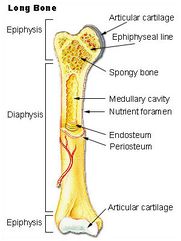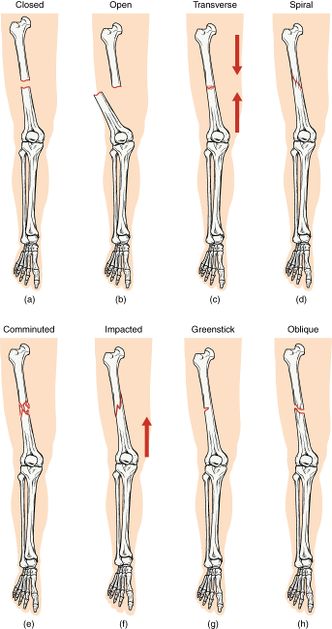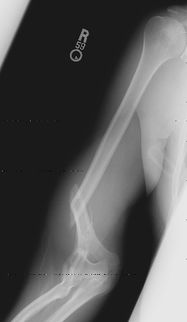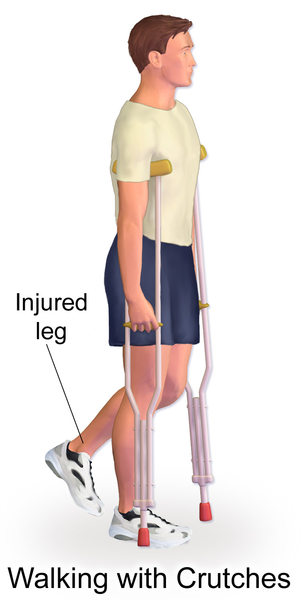Fracture
Top Contributors - Esraa Mohamed Abdullzaher, Naomi O'Reilly, Kalyani Yajnanarayan, Lucinda hampton, Khloud Shreif, Kim Jackson, Claire Knott, Abbey Wright and Aminat Abolade
Definition[edit | edit source]
A fracture is a discontinuity in a bone (or cartilage) resulting from mechanical forces that exceed the bone's ability to withstand them.[1]
Most commonly fractures occur in the setting of a normal bone with acute overwhelming force, usually in the setting of trauma. Fractures can also occur, however, in a variety of other settings.
- The entire skeleton may be weak due to metabolic (e.g. osteoporosis) or less frequently genetic abnormalities (e.g. osteogenesis imperfecta) and thus prone to fractures from forces that would be insufficient to cause fractures in normal bones. These are known as insufficiency fractures.
- The protracted chronic application of abnormal stresses (e.g. running) can result in the accumulation of microfractures faster than the body can heal, eventually resulting in macroscopic failure. These are termed fatigue fractures. Nb. Together, insufficiency and fatigue fractures are often grouped together as stress fractures.
- The bone may have a lesion that focally weakens a bone (e.g. metastasis, or bone cyst). These are known as pathological fractures.
Location[edit | edit source]
- Which bone is fractured; long bone as the humerus, short bone as in carpal bones, flat bone such as scapulae and ribs, sesamoid bone as in patella, and irregular bone ( vertebrae and skull)
- Which part of the bone is affected
- General: epiphysis, physis, metaphysis, diaphysis; specific features: e.g. tubercle, epicondyle, etc.
Types Of Bone Fracture[edit | edit source]
Fractures usually fall within a set number of patterns:
- Complete fracture: extends all the way across the bone (most common)
- Transverse fracture: perpendicular to the axis of the bone
- Oblique fracture: orientated obliquely across the bone
- Spiral fracture: helical fracture path usually in the diaphysis of long bones
- Comminuted fracture: more than two parts
- Incomplete fracture: does not cross the bone completely (usually encountered in children)
- Bowing fracture: an incomplete bone fracture of the long bone in infants and children due to forces in the axial load[2].
- Buckle fracture: due to direct axial load, the cortex is buckled, often in the distal radius
- Greenstick fracture: the cortex is broken, but only on one side[1]
- Bowing, buckling, and greenstick fracture are types of fractures common in children.
In general, the fracture has many classifications, according to the position of the ends of bone fracture, displaced or non displaced. Complete or incomplete fracture. Transverse or vertical fracture according to the orientation of the fracture. Simple or compound according to the penetration of the skin.
Pathophysiology Of Bone Healing[edit | edit source]
The pathophysiological sequence of events that occur following a fracture can be divided into three main phases[3][4]:
- Inflammatory
- Reparative
- Remodeling
Inflammatory Phase[edit | edit source]
Immediately at the time of fracture, the space between fracture ends is filled with blood-forming a hematoma.
- Stops additional bleeding; provides structural and biochemical support for the influx of inflammatory cells, fibroblasts, chondroblasts and the ingrowth of capillaries
This process takes approximately a week, forming a primary callus which is non-mineralized and not readily visible on radiography
Reparative Phase[edit | edit source]
Over the next few weeks, this primary callus is transformed into a bony callus by the activation of osteoprogenitor cells. These cells lay down woven bone which stabilises the fracture site.
Remodeling Phase[edit | edit source]
This phase lasts many months, maybe years, and represents the gradual formation of compact cortical bone with greater biomechanical properties and allows for the reduction of the width of the callus. Remodeling can result in almost perfect healing, however, particularly if the alignment is not perfect, a residual deformity will remain.[1]
Complications[edit | edit source]
Many of the aforementioned fracture types can also go on to have additional complicating features (and many associated soft tissue injuries)
- Acute compartment syndrome is common in the fracture of the forearm.
- Fat embolism syndrome (a piece of fat that released into the blood vessels causing blockage of blood flow) [6] that is most commonly associated with long bone and pelvic fracture[7]
- Osteomyelitis of bone in response to infection.
- Healing complications: malunion, delayed union, or nonunion. [8]
- Avascular necrosis
- Fracture blisters
- Compound fracture: extending through the skin
- Joint involvement: intracapsular; articular; dislocation
Clinical Features of Fracture[edit | edit source]
Clinical features vary depending on the cause and nature of the injury and range from unconsciousness to the patient being able to use the limb, although complaining of pain. These features are :
- Pain (Image at arm following a boxing injury, painful)
- Deformity
- Oedema
- Loss of function
- Muscle spasm
- Muscle atrophy
- Abnormal movement
- Limitation of joint motion
- Shock
When is Fracture Healed[edit | edit source]
The answer to this question depends upon many factors, including :
- The type of bone fractured
- The type of fracture sustained
- The age of the person
- The treatment undergone
- The nutritional status of the person.
A fracture is considered to be clinically healed based upon the combination of physical findings and symptoms over time.
And the following suggest complete healing :
- Absence of pain on weight-bearing, lifting or movement
- No tenderness on palpation at the fracture site
- Blurring or disappearance of the fracture line on X-ray
- Full or near full functional ability[10].
Treatment and Prognosis[edit | edit source]
The basics of fracture healing rely on alignment and immobilisation.
Alignment may or may not be necessary depending on the degree of displacement, the importance of correct alignment (e.g. index finger vs rib) and the patient (e.g. professional athlete vs debilitated elderly).
Immobilisation can be achieved in a variety of ways depending on the location and morphology of the fracture.
- None (e.g. most rib fractures)
- Sling (e.g. many clavicular fractures)
- Cast (e.g. many forearm fractures)
- Internal fixation (e.g. most hip fractures)
- External fixation
Role of Physiotherapy[edit | edit source]
The physiotherapist’s role is to identify the cause of the problem and to select the appropriate procedure to alleviate or eliminate the cause of the loss of movement. Examples of early treatment include
- A physical therapist may instruct the client how to walk with an assistive device, like a cane or crutches. This includes how to use the device to walk up and down stairs or to get into and out of a car. Learning a new skill takes practice, so be sure to allow client practice using your device while they are with you.
- After a lower extremity fracture there may limit the amount of weight client can put on the leg. Help the client understand weight bearing restrictions and teach how to move about while still maintaining these restrictions.
- If the fracture is in the arm, you as the physical therapist may teach you how to apply and remove the sling
Doing an assessment for the patient is necessary also doing The problem-oriented medical record (POMR) system ( is based on a data collection system that incorporates the acronym SOAP:
- Subjective – any information given to you by the patient: allergies, past medical history, past surgical history, family history, social history (living arrangements, social conditions, employment, medication), review of systems .
- Objective – all information obtained through observation or testing, e.g. range of joint movement, muscle strength .
- Analysis – a listing of problems based on what you know from a review of subjective and objective data.
- Plan – this refers to the plan of treatment).
Also By Using specific exercises, the aim is to reduce any swelling, regain full muscle power and joint movement and to bring back full function. The treatment will depend very much on the problems identified during your initial assessment, but may include a mixture of the following:
- Soft tissue massage, particularly to manage Edema and swelling
- Scar management if the patient had surgery to fix the fracture
- Ice therapy
- Stretching exercises to regain joint range of movement
- Joint manual therapy and mobilizations to assist in regaining joint mobility
- Structured and progressive strengthening regime
- Balance and control work and gait (walking) re-education where appropriate
- Taping to support the injured area/help with swelling management
- Return to sport preparatory work and advice where required[10]
References[edit | edit source]
- ↑ 1.0 1.1 1.2 Radiopedia Fracture Available from:https://radiopaedia.org/articles/fracture-1 (last accessed 2.4.2020)
- ↑ https://radiologykey.com/types-of-fractures-in-children/
- ↑ Bahney CS, Zondervan RL, Allison P, Theologis A, Ashley JW, Ahn J, Miclau T, Marcucio RS, Hankenson KD. Cellular biology of fracture healing. Journal of Orthopaedic Research®. 2019 Jan;37(1):35-50.
- ↑ Kostenuik P, Mirza FM. Fracture healing physiology and the quest for therapies for delayed healing and nonunion. Journal of Orthopaedic Research®. 2017 Feb;35(2):213-23.
- ↑ Whats Up Dude. How Does A Bone Break Heal - Bone Fracture Healing Process. Available from: http://www.youtube.com/watch?v=od8oU5OLMGU[last accessed 8/6/2020]
- ↑ Maitre S. Causes, clinical manifestations, and treatment of fat embolism. AMA Journal of Ethics. 2006 Sep 1;8(9):590-2.
- ↑ Hershey K. Fracture complications. Critical Care Nursing Clinics. 2013 Jun 1;25(2):321-31.
- ↑ Jackson LC, Pacchiana PD. Common complications of fracture repair. Clinical techniques in small animal practice. 2004 Aug 1;19(3):168-79.
- ↑ Jay Cheon. Complications of fractures. Available from: http://www.youtube.com/watch?v=RKScXgsYXwk[last accessed 8/6/2020]
- ↑ 10.0 10.1 Tidy's Physiotherapy Chapter 22 Churchill Livingstone Elsevier London 2013










